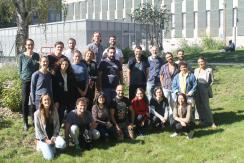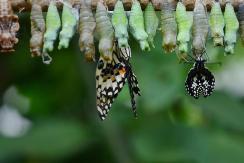COEVOL Multi-Scale Coevolution
Living systems are highly integrated, with a multitude of levels of organization, from molecular and intra-cellular scales to ecosystems. Complex organisms are themselves consortia of macro- and micro-organisms, which work together with their host to build the individual. Yet, each of these organisms can function and evolve in the short term according to its own logic, possibly in conflict with other higher or lower levels, or with other time scales. The once common idea among evolutionists that natural selection results in organisms perfectly adapted to their environment is now severely undermined. Not only because, as the Red Queen explains to Alice, one has to run relentlessly to keep its place in a changing environment, or because past evolutionary history and chance constrain the possibilities of present adaptation, but also because different levels of selection have interests that are generally difficult to reconcile.
Multi-scale coevolution resets classical questions in evolutionary biology
One example, of particular interest is the question of the source of heritable variations. The phenotype of organisms in a population is influenced not only by variations in their nuclear and mitochondrial genomes, the dynamics of which is the object of population genetics, but also more and more patently by the consortium of microbes and genetic elements that constitute its microbiome and virome. The hologenome designates this complex assembly of genetic materials, which obey different rules of transmission and different evolutionary strategies. The ability of symbionts to manipulate host phenotypes or to interfere with each other influences the evolutionary dynamics of all players in ways that are yet poorly understood. In addition, new questions arise, such as the importance of co-adaptation in these systems and their consequences in maintaining cohesive biological systems.
- Symbiosis: a response to and a source of divergent selection
Using a variety of approaches combining experimental evolution, genomic, functional, phenotypic and behavioral data, we aim to test whether symbiosis facilitates diversification and to characterize the underlying microevolutionary processes.
- Ecological networks of horizontal gene transfer
We develop original methods to detect gene transfer and we investigate the factors that influence the routes of gene transfers among microbes but also among insects.
- The interplay between symbiosis, infection and immunity and its evolutionary consequences
We try to understand the intimate interaction of hosts with pathogens, symbionts and transposable elements and how it affects the extended phenotype of the host.
- Transgenerational inheritance and environment changes
We try to decipher the molecular mechanisms that underlie rapid adaptation to environment and to test for transgenerational inheritance of fitness traits.
- Intragenomic conflicts and demography
We are developing models to test whether changes in the demography of the host affect the dynamics of transposable elements.
- The determinism of phenotypic convergence
We study the genomic basis of convergent phenotypic evolution in particular in the case of animals and plants adaptation to increasing temperature and decreasing water.
- Reconciling the tree of life
We develop phylogenetic methods for “reconciling” gene/species or host/symbiont histories and use these methods to explore the bulk of extinct or undescribed species and the history of association of symbiotic microbes with their hosts.
Integrating methods
The methods we use to tackle the questions raised by multi-scale co-evolution extend from theory, modelling and simulation to big data analysis, lab (notably on insects), and to a lesser extent, field activities.
Implication of research, responsibility of researchers and citizen sciences
From our research (some of which have immediate consequences in health, agriculture and ecology) and our concerns about the responsibility of scientists in society, we are committed to promote an “implicative” research. The implicative position means that we try to work on the link between science and society, not only through a one-way communication, applying or explaining our science, but also favoring early discussions on research projects, that may influence our research directions.
Publications
Display of 181 to 210 publications on 706 in total
Transposable element dynamics and regulation in a major crop pest: Sitophilus oryzae.
Congrès national sur les éléments transposables .
Poster
see the publicationDiscovering the link between insect symbiosis and transposable elements.
Crossroads between transposons and gene regulation .
Poster
see the publicationInfluence of bacterial symbionts on host niche and ecological diversification: a metabolic approach in a whitefly model.
Auvergne Rhône-Alpes Regional Workshop on Microbiome .
Poster
see the publicationInfluence of bacterial symbionts on host niche and ecological diversification: a metabolic approach in a whitefly model.
Colloque Réseau Ecologie des Interactions Durables (REID) et le réseau Immunologie des Invertébrés (IMMUNINV) .
Poster
see the publicationInfluence of symbionts on their host niche and partner's choice
2nd annual meeting of Japan-France Plant-Insect-Symbiont Interaction network (PISI-net) .
Conference paper
see the publicationStudy of insect-bacteria symbiotic interactions by dual RNAseq
Journée Transcriptomique Complexe des GDR GE et BIM .
Conference paper
see the publicationTransposable element dynamics in Sitophilus oryzae
Auvergne Rhône-Alpes Regional Workshop on Microbiome .
Poster
see the publicationSublethal effects from endosulfan on parasitization by the parasitoid wasp Leptopilina boulardi and specificity of nervous pathways involved
Pest Management Science . 75 ( 5 ) : 1411-1415
DOI: 10.1002/ps.5261
Journal article
see the publicationQuand les branches de l’arbre du vivant s’entremêlent
Pour la science .
DOI: 10.3917/pls.506.0056
Journal article
see the publicationGlobal survey of mobile DNA horizontal transfer in arthropods reveals Lepidoptera as a prime hotspot
PLoS Genetics . 15 ( 2 ) : e1007965
Journal article
see the publicationZombi: A phylogenetic simulator of trees, genomes and sequences that accounts for dead lineages
Bioinformatics .
Journal article
see the publicationOn the Importance to Acknowledge Transposable Elements in Epigenomic Analyses
Genes . 10 ( 4 ) : 258
Journal article
see the publicationSymbiotic organs shaped by distinct modes of genome evolution in cephalopods
Proceedings of the National Academy of Sciences of the United States of America .
Journal article
see the publicationComparative Transcriptomics Analyses across Species, Organs, and Developmental Stages Reveal Functionally Constrained lncRNAs
Molecular Biology and Evolution .
Journal article
see the publicationTracing Human Ancestral Migrations Using Symbiotic Bacteria
Groupe des Méthodes Pluridisciplinaires Contribuant à l'Archéologie (GMPCA) .
Conference paper
see the publicationDynamic Interactions Between the Genome and an Endogenous Retrovirus: Tirant in Drosophila simulans Wild-Type Strains
G3 . 9 ( 3 ) : 855-865
Journal article
see the publicationTanglegrams Are Misleading for Visual Evaluation of Tree Congruence
Molecular Biology and Evolution . 36 ( 1 ) : 174-176
Journal article
see the publicationGene tree reconciliation including transfers with replacement is NP-hard and FPT
Journal of Combinatorial Optimization . 38 ( 2 ) : 502–544
Journal article
see the publicationGene tree species tree reconciliation with gene conversion
Journal of Mathematical Biology . 78 ( 6 ) : 1981–2014
Journal article
see the publicationGC-biased gene conversion conceals the prediction of the nearly neutral theory in avian genomes
Genome Biology . 20 ( 1 )
Journal article
see the publicationCAARS: comparative assembly and annotation of RNA-Seq data
Bioinformatics . 35 ( 13 ) : 2199-2207
Journal article
see the publicationDetecting adaptive convergent amino acid evolution
Philosophical Transactions of the Royal Society B: Biological Sciences . 374 ( 1777 ) : 1-11
Journal article
see the publicationGene transfers can date the tree of life
Nature Ecology & Evolution . 2 ( 5 ) : 904-909
Journal article
see the publicationTick-Bacteria Mutualism Depends on B Vitamin Synthesis Pathways
Current Biology . 28 ( 12 ) : 1896 - 1902.e5
Journal article
see the publicationCancer Is Not (Only) a Senescence Problem
Trends in Cancer . 4 ( 3 ) : 169 - 172
Journal article
see the publicationAbundance of Bemisia tabaci Gennadius (Hemiptera: Aleyrodidae) and its parasitoids on vegetables and cassava plants in Burkina Faso (West Africa)
Ecology and Evolution . 8 ( 12 ) : 6091-6103
DOI: 10.1002/ece3.4078
Journal article
see the publication

